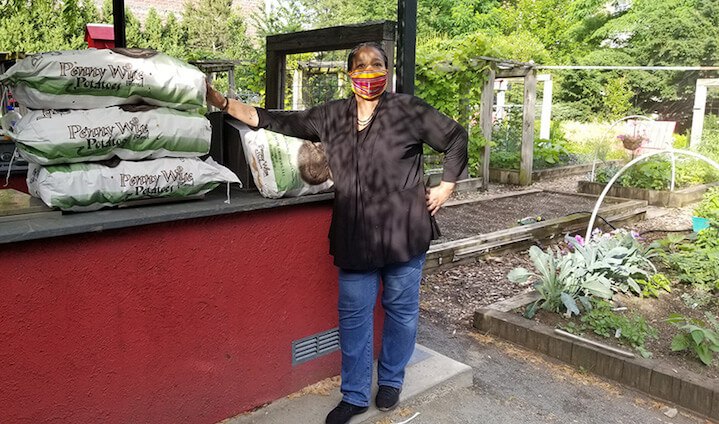Annual Report | February 26, 2021
Annual Report 2020: Building Urban Resilience
 Target Bronx garden member Miriam Tabb helps collect potatoes to distribute to community members. Credit: Miriam Tabb
Target Bronx garden member Miriam Tabb helps collect potatoes to distribute to community members. Credit: Miriam Tabb The following blog post is an excerpt from our 2020 annual report that you can read here.
When lockdown began in March, the essential nature of our parks and gardens became immediately clear. Spring was around the corner and New Yorkers needed to get outside safely. NYRP community garden members—volunteers who work together to steward each garden—doubled down on using their spaces to serve their neighbors.
Our Engagement and Programming team instituted regular online meetings to help identify and solve common challenges and amplify best practices across our 52 community gardens. Garden groups in turn increased food production, distributed fresh produce, supplemented non-perishable food giveaways, and stocked nearby free food fridges. They joined local partners and elected officials to give away essential supplies including homeschool materials and PPE.
“Our gardens are fully ingrained in community,” describes Senior Director of Engagement and Programming Annel Cabrera-Marus, “Having a garden in a community is not a luxury; it serves a purpose.”
NYRP’s Operations team supplemented these garden group efforts by distributing over 300 plant starts and 400 seed packets throughout the season. They also built over 30 new garden beds and consulted with garden groups to maximize vegetable growing capacity, all while providing necessary tools and water access to help them maintain their crops.
The Living Shoreline
Meanwhile our parks in northern Manhattan experienced their highest level of usage since we began overseeing them in partnership with the City in the nineties. Sherman Creek Park is a cornerstone of the Inwood neighborhood that is threatened by climate change-induced erosion and sea level rise. We’ve been researching ways to protect it for years and 2020 was when we had planned to introduce an ecosystem-based solution called a living shoreline.
Integrating native plantings and an artificial oyster reef, our living shoreline design aims to not only attenuate waves that wash away sediment but also enhance the native wetland habitat—one of the last of its kind in all of Manhattan. By stacking specialized concrete blocks called Oyster Castles, its design helps build new habitat for marine species that, over time, could transform the dynamics of a park that we might otherwise lose.
Pandemic-related mandatory work stoppages and permitting complications put the start of the project in question. The necessary pieces eventually aligned, however, and by summer our Operations team and a handful of volunteers began the project with full force, all while wearing masks and social distancing. They were able to complete the installation in phases and by the fall, wild juvenile oysters arrived on their own, proving both the improving health of the Harbor and the suitability of the habitat.
We continue to monitor the shoreline’s evolution in partnership with Dr. Chester Zarnoch and his students at Baruch College to better understand and quantify the ecosystem services that urban wetland restoration projects like ours might offer. “We know that, acre per acre, wetlands are better than forests at fighting climate change,” says Director of Northern Manhattan Parks Jason Smith. “It just requires shifting our relationship with the landscape and realizing it’s not about building a big project and walking away; it’s about staying engaged, stewarding it, and learning from it.”